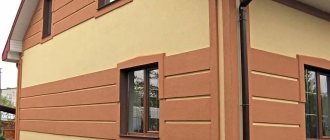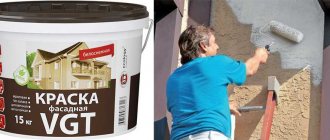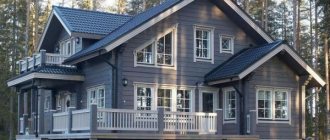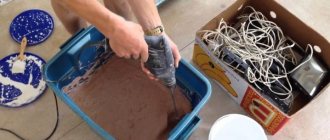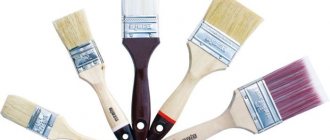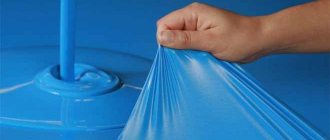Exterior finishing materials come in a variety of types and shapes. Relief coatings that can “revive” the surface have recently become especially popular.
Working with such materials is somewhat more difficult than with ordinary ones; it requires a certain plan and skills in such work. But the result is worth the effort, since it creates an original, stylish surface with a non-standard appearance.
One of these coatings is textured facade paint, the use of which differs significantly from the usual technology for applying external coatings. Let's take a closer look at it.
Characteristics of textured paint
Textured paint is an external coating that creates a relief surface with a different type of pattern and volume. At the same time, the result is determined not only by the composition of the paint. The appearance of the coating largely depends on the application method, as well as on the shape of the tool used . A surface is created in which several properties are harmoniously combined - color, degree of gloss, type and size of the applied relief. There can be a great variety of possible combinations of these properties, which makes each use case original and different from the others.
In order for a material to have such qualities, an unusual physical composition is required - high viscosity, the presence of various fillers (for example, ordinary river sand).
It is the fillers that make it possible to maintain a certain shape and not spread over the entire surface or flow to the ground. The height of the relief can be quite large, and the size of the filler grains determines the ability of a given composition to form a pattern of varying degrees of volume.
In addition, the application method itself allows you to create completely different types of textures from the same material. There are a huge number of options in this matter - the size of the tool, the type of pattern, binding to geometric shapes or complete chaos - all methods are good in their own way and can be used, you just need to have the technique of applying textured paints.
Textured paints can be used on different types of substrates:
- Brick.
- Concrete.
- Plaster.
- Drywall.
- OSB.
- Wood.
- Metal.
- Stone, etc.
IMPORTANT!
The larger the size of the filler, the higher the consumption of material, but also the more options for the design that can be applied with such paint.
In addition to decorative qualities, textured paints also perform other functions inherent in external coatings:
- Protect walls from water penetration.
- Provides steam outlet.
- Eliminates the occurrence of mold, mildew, etc.
Thus, structural paints are the same exterior coatings, but with an enhanced decorative effect.
Features of structural paint for facades
Facade structural paint allows you to create a decorative coating that will have a visual structure and is used to decorate mineral surfaces pre-treated with a primer.
The main chemical component of façade structural paint is a water-polymer latex dispersion. The set of substances in the composition of the material varies depending on the required properties of the finished coating and the brand. It may contain various pigments, fillers and other substances to change the appearance.
The difference between structural paint for facade work is its high viscosity and hiding power. The thick consistency makes it possible to manually form the surface relief. The coating is protected from rapid destruction and wear by a film that forms during application. Thanks to this natural protective mechanism, cured paint can last for years without losing its aesthetics or performance properties.
Today there are structural paints for walls and facades. Unlike material for interior decoration, the composition of facade paint is supplemented with special additives that enhance resistance to mechanical stress and the destructive influence of climate.
In terms of harm to humans, structural exterior paint does not contain toxic or poisonous chemicals that could be harmful to health, and therefore can be used both indoors and outdoors.
Types of textured facade paint
Textured paints differ in size and type of filler . It is this that makes it possible to create a certain structure of the paint layer and imitate some natural textures.
For example, bark beetle paint imitates the surface of wood damaged by insects. “Fur coat” or “lamb” effects, which have a uniformly rough relief of varying heights, are also widespread.
External use somewhat limits the possibilities of textured paints, since weather or atmospheric conditions interfere with the situation. We have to work as quickly as possible, so some types of coatings that are successfully implemented on internal surfaces cannot be performed on the facade.
Most often on today's market you can find textured paints based on water-dispersed acrylic mixtures . They best combine performance, price and performance. However, some manufacturers successfully produce organic solvent-based textured paints using traditional, time-tested materials. Almost all external coatings are certified, have all the necessary qualities, and fully comply with the declared characteristics.
Application
The main stages of work: preparation of the surface and paint, its application to the facade, decoration. Decorating consists of painting the finished wall or applying additional layers.
You can choose any shades for the facade to your liking if you add color to the solution in different proportions. If the surface has significant defects, it is better to smooth it out with putty.
There is a large range of textured enamels, and you can use them to give the surface both a smoother and a very rough structure. The consumption of material with a rough structure is greater than with a smoother one, but with such material you can create a greater number of different patterns, and it dries faster.
Before work, you need to prepare the surface so that the paint can adhere securely and maintain its strength for a long time. The surface must be cleaned of dirt and dried.
Texture materials are applied to a durable surface, both previously painted and new, and visually smooth out unattractive walls. They are made from inexpensive components, which ensures their low price.
The easiest method of applying mortar to walls is with a roller. The paint is pre-mixed with a mixer and the desired color is added. If you use a texture roller, patterns will appear on the surface that imitate a variety of textures.
The roller is moistened abundantly with water and promptly washed from the solution. It is necessary to immediately finish one wall so that after drying the seams will not be visible. Within 5-7 hours after drying, you can apply another layer or paint the surface with classic paint.
If you apply a pattern with a spatula, then the technology of work is different, and the main thing is to create the same pattern on the entire surface of the wall. Patterns, waves, herringbones, imitation stone or wood - textured mixtures provide an interesting relief surface.
Resistance to temperature changes, sunlight, and mechanical stress has ensured the widespread use of textured enamels. They hide minor defects and visually significantly improve the surface.
Responsible surface preparation, the correct choice of materials, and compliance with the recommendations of manufacturers will allow the facade of the building to be maintained in excellent condition for a long time and without repairs.
Features of textured facade paint
The use of textured paint for exterior work has its own characteristics. For example, a relief surface does not require a perfectly flat base ; shallow dents or other flaws will be masked by a specific coating pattern.
At the same time, the paint layer turns out to be thicker than usual, which requires the use of special compounds to facilitate drying. In addition, textured facade paints have increased strength, resistance to abrasion, and mechanical stress.
NOTE!
If necessary, you can make textured paint yourself , for which you need to mix the facade paint with putty in the required proportion, add filler - sand, marble chips, etc. The main thing is that the materials are made in the same company and correspond to each other.
Some brands of paint
There is a wide range of paints and, despite similar types, the performance characteristics of products from different companies differ. Let's get acquainted with the popular paint manufacturers on the market and the features of their brands.
Fassadenfarbe Relief
This paint is suitable for exterior and interior finishing work. With its help, relief decorative and protective coatings are created on new mineral substrates (brick, concrete, plastered, aerated concrete surfaces, and so on). For the paint to dry completely, just wait 4 to 6 hours.
Advantages:
- high hiding power and adhesion to the treated surface;
- easy to apply with a roller, good stability;
- used to hide minor surface defects;
- high vapor permeability and good water-repellent properties;
- relevant for creative modeling and during the creation of unique design solutions.
Before painting, the surface should be thoroughly cleaned, removing old paint. If the wall is freshly plastered, then wait 4 weeks before applying the paint. Before the painting process itself, it is recommended to apply a primer of the same brand to the surface.
VD AK 1180 façade VGT
This paint is used to paint facades and interior surfaces in damp areas. The dye consists of a water-dispersed polymer, filler and pigment. If a reduction in viscosity is required, the paint can be thinned. Dries completely within 24 hours after application.
Peculiarities:
- good adhesion to wood, concrete, brick, plasterboard and plastered surfaces;
- 2 weeks after application, a durable and wet-cleaning resistant layer is created;
- when dry, it looks like a smooth matte surface;
- resistance to light (during operation it will not turn yellow);
- high water and weather resistance;
- good hiding power;
- the formed coating is able to “breathe”.
If necessary, the composition is tinted with special paints and pastes, resulting in pastel or rich colors. For this purpose, automatic tinting machines are used or the work is carried out manually. It is recommended to add no more than 15% tinting paste, which will prevent a decrease in paint strength.
Advantages and disadvantages
The advantages of textured paint are:
- The ability to create a unique surface pattern and realize any fantasies.
- If you have an old coating that is not of the best quality, you can mask surface imperfections, hide cracks or potholes.
- A more durable coating layer than usual.
- High vapor permeability, moisture-proof properties.
- High frost resistance.
- Durability of the coating.
However, there are some disadvantages:
- Application skills required. The technology is simple, but it may not work the first time, so it’s best to start with inconspicuous areas of the walls.
- High material consumption, which at the same time means high costs.
The advantages and disadvantages of textured paints are quite typical for many finishing materials and do not limit their demand among consumers.
Preparation of façade structural paint
The process of preparing structural paint is no different from other varieties of this material. Sales are carried out in buckets, while the material itself is in a thick state. To prepare it for work, you need to add water to a bucket and use a mixer to bring it until smooth.
It is worth remembering that an excessive amount of liquid will worsen the properties of the material, and therefore you need to add water so that its final share does not exceed 11% of the total volume of paint used for the job. According to experts, to achieve the optimal state of aggregation of the material, it is enough to add 2.5% liquid. The water used for dilution must be clean and free of foreign impurities.
For proper tinting, you need to prepare a test section of the wall and apply the material as you mix the paint, observing the color change. This may be a time-consuming task at first, but it will allow you to achieve the perfect color. After drying, the structural paint changes its shade to a duller one. Therefore, to achieve the desired color, you should dry a test area of the wall with a hair dryer.
If a palette is used to select a color, you need to remember the need to match the manufacturers of the color pigment and paint. If these components are from different brands, the color will not match what is described in the palette.
Application tool
To apply textured façade paints, a mechanical tool (spray gun) and various types of hand tools are used, which include:
- Rollers with different types of sandpaper.
- Rubber and metal spatulas, straight or serrated.
- Hard brushes with short bristles.
IMPORTANT!
The use of brushes is ineffective, since the brush is designed to smooth and evenly distribute paint, and the specificity of textured compositions requires the formation of relief.
To form the “bark beetle” structure, a grater is often used, which makes it possible to form grooves and stripes characteristic of this type of relief. You can also use a rubber or Teflon spatula.
Types of tools for work
Technological techniques for applying paint affect the appearance of the surface.
Facade paint is applied in a thicker layer than when using traditional paint. It does not interfere with air circulation and tolerates temperature changes, frost, and high humidity well.
Textured materials with the addition of acrylic binders make it possible to obtain a durable, plastic coating that does not deteriorate from exposure to ultraviolet radiation or harmful precipitation.
Application Tools
- sprayers;
- rollers;
- spatulas;
- sponges;
- combs.
When pneumatic spraying, you need to correctly select the air pressure on the sprayer (about 6 atmospheres) and the distance to the surface to be treated.
With the help of textured material, you can bring any design fantasy to life at little financial expense. Any area painted with this paint can be easily repaired by applying a new composition to the damaged area.
Even a non-professional can paint a facade with a roller, because the technology for carrying out the work is simple and does not require special skills.
Considering that there is no need to heavily level and sand the walls, you can reduce the cost of material consumption, labor and save time.
Surface preparation
Before starting work, it is necessary to clear the surface of the walls from all foreign hanging objects, fasteners, brackets, lanterns, etc. It is recommended to remove trim from window and door openings.
To apply textured paint it is not necessary to have a perfectly flat surface . If the flaws on it are small in size and depth comparable to the height of the relief, then it is not necessary to make any preparation.
However, if there are peelings or shedding of the surface, they should be removed, for which all problem areas must be removed with a spatula . The resulting dents and irregularities should be plastered and a layer of deep penetration primer applied. The layer of plaster should be left for at least a week to complete the crystallization processes and remove alkali from the composition.
Surfaces previously coated with oil paints or enamels should be cleaned of old layers and thoroughly primed.
Using façade texture paint in decoration
Texture paint is a new product that allows you to give the surface of the walls any texture and texture. You can create a variety of color shades yourself by adding various additives.
Modern texture paint is a universal material. It provides a decorative coating and at the same time levels the surface. Stylish, wear-resistant textured enamel gives the facade an interesting appearance and protects from the effects of various harmful natural factors.
Application technology
When using a spray gun (spray gun), a surface with uniform roughness is obtained . It will not be possible to apply a specific design in this way, but this method is optimal for reducing time and increasing productivity.
Manual application of textured paints is carried out using one of the selected tools. The roller makes it possible to create a structure with a fine relief (if the roller is smooth) or with a larger one (if a long-pile sandpaper is used).
Using a spatula makes it possible to create various geometric shapes, repeated in different variations or sizes . At the same time, the presence of a large number of heterogeneous relief elements on one wall is visually perceived as a chaotic pile-up, sloppy work.
It should be remembered that any, even the most asymmetrical, pattern obeys certain laws and must have some kind of logic or repeatability. Practice shows that figures that are not too complex , having approximately equal area and not too large in size, look most impressive.
When choosing a design, you should constantly limit yourself so as not to overdo it with elements that are too confusing and sloppy.
The use of textured facade paints creates a complete exterior coating that has high performance qualities combined with an enhanced decorative effect. The complexity of application and increased paint consumption are fully justified by the result obtained, creating a stylish, original look for the facade of the house.
If you do not have the skills to work with such materials, it is better to invite a specialist, or at least start working from the rear walls, invisible from the street. In any case, the result will be a unique design that decorates the walls of your home.
Proper application of structural paint
The facade is painted in a layer of 2.5-3.5 mm. It is this thickness of the layer that allows you to achieve the results that structural paint can achieve. In this case, you need to distribute the material evenly over the surface, saturating the tool with paint more often than when using conventional paints.
The main condition for high-quality work in full accordance with technology is prompt staining. It is necessary to treat one wall at a time. If you extend the processing process for several days or more, then different shades will appear on the frozen surface, since some areas froze earlier and faded, while others later.
If a pneumatic gun is used to apply the material, the result will be an original drip texture. The gun allows you to adjust the size of the spray droplets, and with this feature you can create unique drip patterns.
After completing the painting work and slightly hardening, you can refine the structural surface by smearing. The method consists of smearing the edges that were formed from the movements of the roller during the application of the material to the original wall. A metal spatula is used for lubrication. This creates the effect of an old wall. The method is applicable both for facade and interior decoration.
